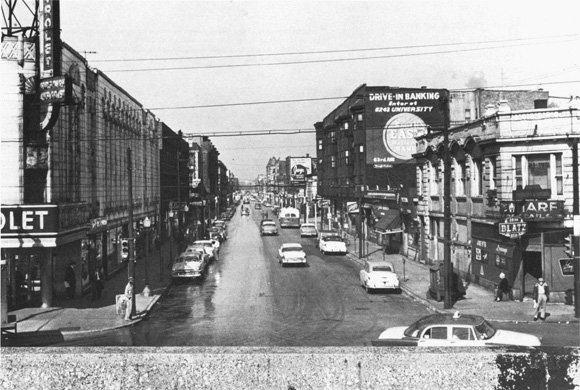Hyde Park Remembered
From 1920 through the era of urban renewal in the 1950s, Hyde Park began to experience the changes that were affecting all large cities in the Northeast and Midwest. Shifting patterns of economic growth, the burgeoning of far-distant suburbs, the great migration of African-Americans from the rural South, and the incipient flight of middle- and upper-class whites from the city all started to have their cumulative effect. Throughout these decades, Hyde Park maintained its reputation as a lively neighborhood that offered gracious living, a diversity of services, and the opportunity for spirited encounters with the latest in the arts and entertainment.
In 1986, Thomas Park, Professor Emeritus of Biology at the University, offered his reminiscences of the neighborhood where he had lived since 1920:
I have a recollection of Hyde Park as a place that's been very green .. . From the beautiful array of elm trees on the Midway throughout the whole of Hyde Park . .. and Kenwood and all of Jackson Park, there's a very strong recollection in my mind of wonderful leafing and flowering.Another impression I had of Hyde Park was its tidy quality ... there was very little litter. Graffiti was an unknown event. We did have one source of filth ... coal dust, because most of Hyde Park was fired for many years with coal furnaces ... you could feel the coal dust everywhere, on your face and on your person and in your books and in your possessions. It was a great blessing when Hyde Park converted from coal to oil. I think the thing I remember most pleasantly about Hyde Park both as a boy and as a young man and as an older man was the quality and diversity of the shops. In (the 1930s and 1940s] one could start at the corner of Lake Park Avenue and 35th Street and walk to Cottage Grove ... and one could find two movie houses, the Jefferson and the Frolic. In somewhat later years, a marvelous pub and jazz emporium called the Beehive, where Miff Mole played. A saloon on the corner known as The Wharf had a very questionable reputation because it was inhabited by many women who blonded their hair ... A few doors down was a very famous old Hyde Park saloon known as Hanley's ... which remained open during Prohibition ... [It was particularly popular with streetcar motormen and conductors, with truck drivers, and with University professors. It was just filled with University professors during Prohibition.
Shops and restaurants lined
55th Street, including bakeries, a fancy-foods grocery, a butcher, toy
shop, several restaurants, the Woodlawn Tap, and the University State
Bank. Nightclubs and ballrooms clustered at 63rd Street south of the
Midway:
At Cottage Grove [and] 63rd Street .. . one would find . .. the Tivoli Theater, which was a large luxury theater, much like the Chicago Theater. There was also the Trianon Ballroom, which was a place where one would go to dance and pick up dates ... the Midway Gardens (at 60th and Cottage Grove) was also a dance hall, but of lower repute, which had the great distinction of bringing [up] a man from New Orleans named King Oliver who brought with him a young trumpet player... named Louis Armstrong. Louis Armstrong used to play there, and some of us would go hear him play. He was superb.


